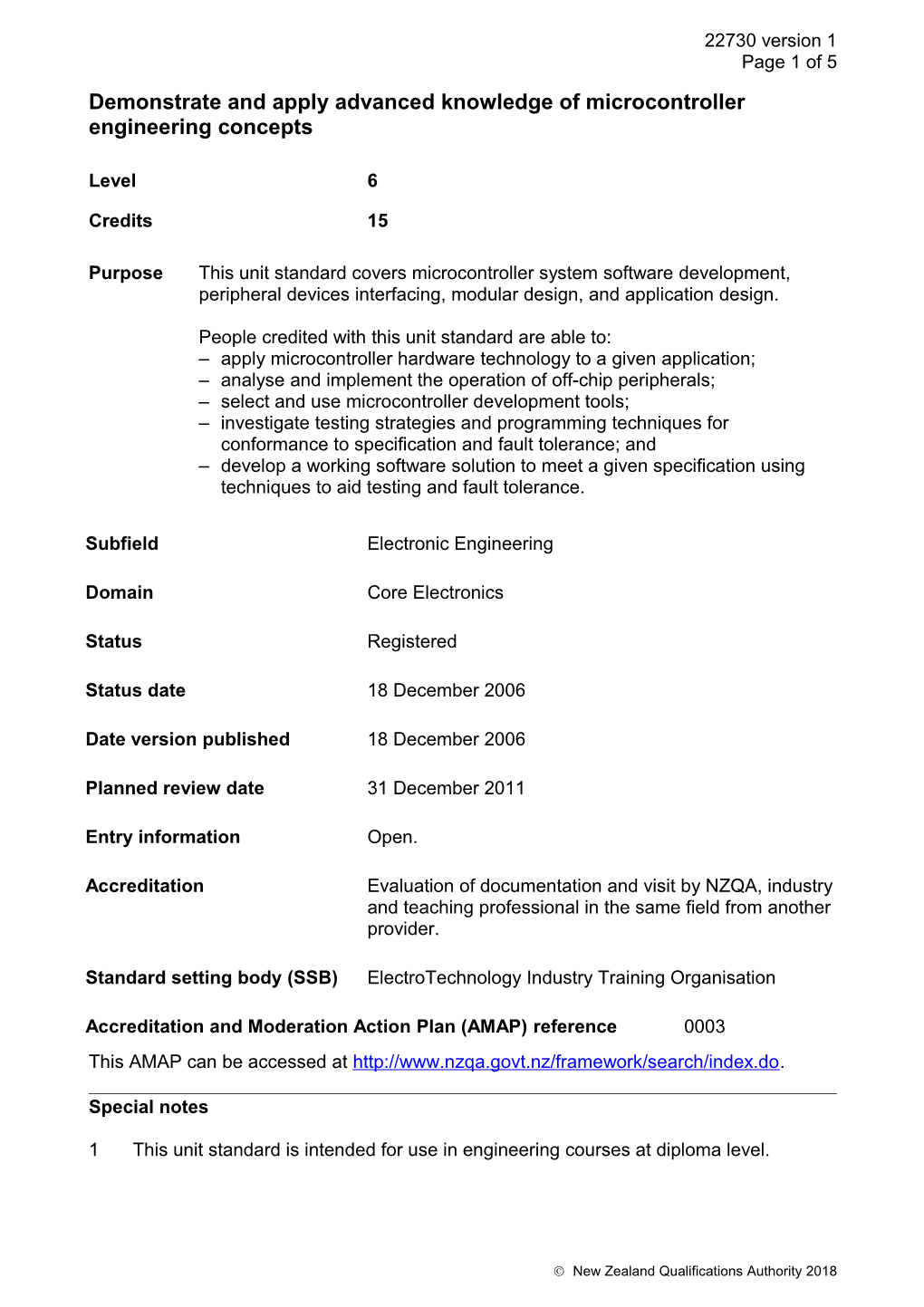22730 version 1
Page 1 of 3
Demonstrate and apply advanced knowledge of microcontroller engineering concepts
Level / 6Credits / 15
PurposeThis unit standard covers microcontroller system software development, peripheral devices interfacing, modular design, and application design.
People credited with this unit standard are able to:
–apply microcontroller hardware technology to a given application;
–analyse and implement the operation of off-chip peripherals;
–select and use microcontroller development tools;
–investigate testing strategies and programming techniques for conformance to specification and fault tolerance; and
–develop a working software solution to meet a given specification using techniques to aid testing and fault tolerance.
Subfield / Electronic EngineeringDomain / Core Electronics
Status / Registered
Status date / 18 December 2006
Date version published / 18 December 2006
Planned review date / 31 December 2011
Entry information / Open.
Accreditation / Evaluation of documentation and visit by NZQA, industry and teaching professional in the same field from another provider.
Standard setting body (SSB) / ElectroTechnology Industry Training Organisation
Accreditation and Moderation Action Plan (AMAP) reference / 0003
This AMAP can be accessed at
Special notes
1This unit standard is intended for use in engineering courses at diploma level.
2This unit standard is one of two that cover knowledge of electrical circuit engineering the other being Unit 22728, Demonstrate and apply intermediate knowledge of microcontroller engineering concepts, which this unit standard builds on. It is recommended that competency in unit standard 22728 be achieved before assessment against this unit standard is attempted, or equivalent knowledge and skills demonstrated.
3Reference
Health and Safety in Employment Act 1992;
and all subsequent amendments and replacements.
4Definitions
ADC – analogue digital converter.
Advanced knowledge – means employing specialised knowledge, with depth in more than one area of the subject matter, to analyse, reformat, and evaluate a wide range of information.
CPU – central processing unit.
d.c. – direct current.
I/O – input/output.
I2C – inter-integrated circuit.
ICE – in-circuit emulator.
IDE – integrated development environment.
Industry practice – practice used and recommended by organisations involved in the electrotechnology industry.
LIN – local interconnect network.
POST – power on self test.
SPI – serial peripheral interface.
5All measurements are to be expressed in Système International (SI) units, and, where required, converted from Imperial units into SI units.
6All activities must comply with: any policies, procedures, and requirements of the organisations involved; the standards of relevant professional bodies; and any relevant legislative and/or regulatory requirements.
7Range
aperformance in relation to the elements of this unit standard must comply with the Health and Safety in Employment Act 1992;
blaboratory and workshop safety practices are to be observed at all times.
Elements and performance criteria
Element 1
Apply microcontroller hardware technology to a given application.
Performance criteria
1.1Physical and commercial microcontroller hardware constraints are identified and considered against a design brief and data sheets.
Rangemay include but is not limited to – microcontroller family, clock speed, memory, hardware/software response times, on-off board peripheral I/O, cost, software/hardware trade-off, development tools, manufacturing quantity.
1.2Microcontroller hardware technology is applied to a given application in accordance with industry practice.
Element 2
Analyse and implement the operation of off-chip peripherals.
Rangemay include but is not limited to – I2C, SPI, single wire bus, LIN.
Performance criteria
2.1The operation of off-chip peripherals is analysed and the results are used to implement their operation in accordance with industry practice.
Rangeevidence of input and output devices is required.
Element 3
Select and use microcontroller development tools.
Performance criteria
3.1The characteristics and areas of application of different microcontroller development tool features are explained in accordance with industry practice.
Rangemay include but is not limited to – ICE, software simulator, low and high level debugging, evaluation board cost considerations.
3.2Development tools are used to develop a software program that satisfies a design brief in accordance with industry practice.
Rangeat least two different development tools.
Element 4
Investigate testing strategies and programming techniques for conformance to specification and fault tolerance.
Performance criteria
4.1Testing strategies and techniques are described in accordance with specification requirements and industry practice.
Rangeproject simulation, on-board diagnosis, I/O exercising.
4.2Fault tolerance methods are consistent with the specification.
Rangemay include but is not limited to – watch dog timer and tasks, POST, microcontroller supervisory power control chip.
Element 5
Develop a working software solution to meet a given specification using techniques to aid testing and fault tolerance.
Rangehigh-level or assembly language is written, debugged and documented, that can control at least three peripheral devices using interrupts.
Performance criteria
5.1Software for a microcontroller is developed to meet a given specification.
5.2Different programming techniques applicable to microcontroller systems are explained and applied to either on board or off board peripheral devices to aid testing and fault indication.
Rangepolled main loop, event driven.
5.3The software solution is documented in accordance with industry practice.
Please note
Providers must be accredited by the Qualifications Authority, or an inter-institutional body with delegated authority for quality assurance, before they can report credits from assessment against unit standards or deliver courses of study leading to that assessment.
Industry Training Organisations must be accredited by the Qualifications Authority before they can register credits from assessment against unit standards.
Accredited providers and Industry Training Organisations assessing against unit standards must engage with the moderation system that applies to those standards.
Accreditation requirements and an outline of the moderation system that applies to this standard are outlined in the Accreditation and Moderation Action Plan (AMAP). The AMAP also includes useful information about special requirements for organisations wishing to develop education and training programmes, such as minimum qualifications for tutors and assessors, and special resource requirements.
Comments on this unit standard
Please contact the ElectroTechnology Industry Training Organisation you wish to suggest changes to the content of this unit standard.
New Zealand Qualifications Authority 2018
